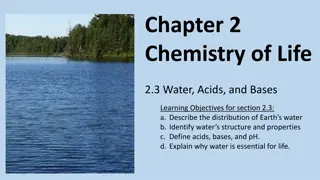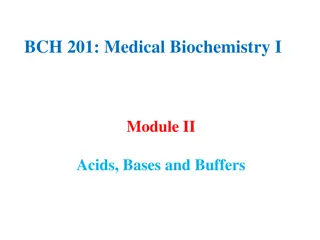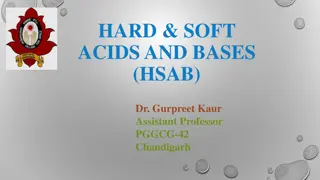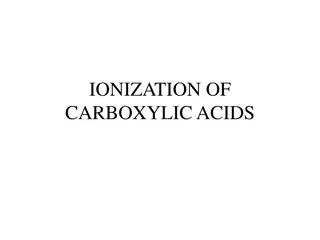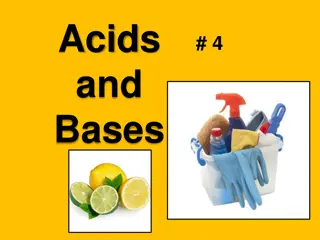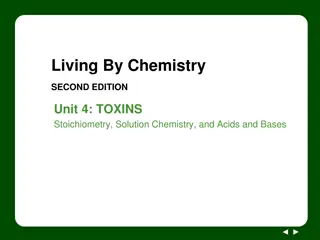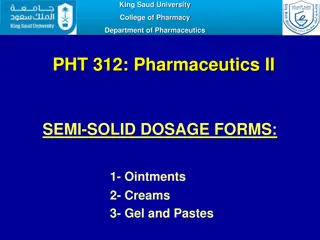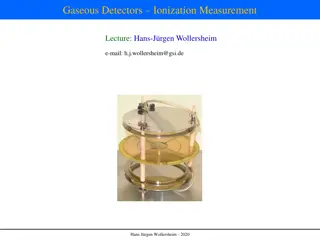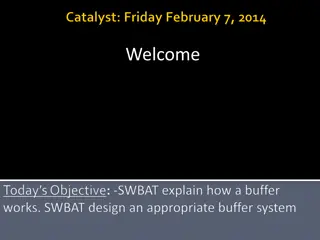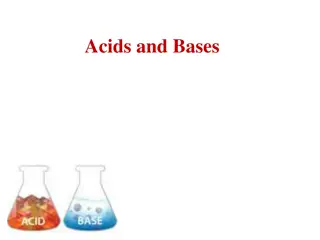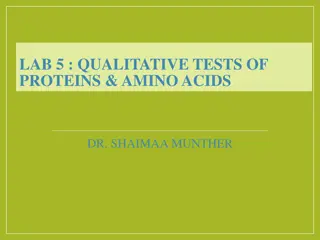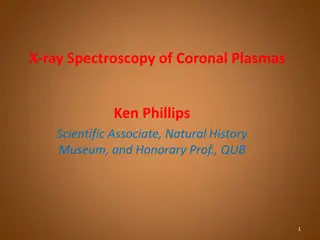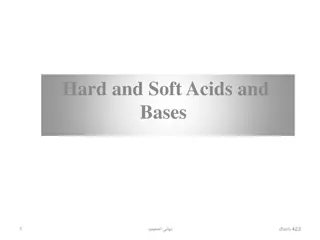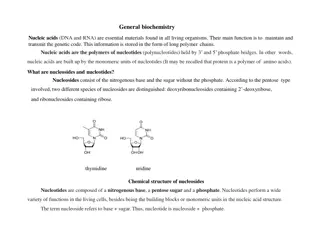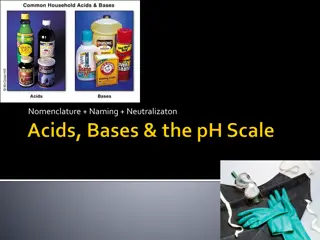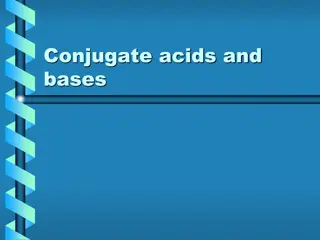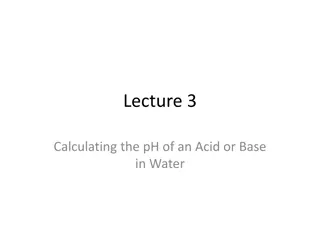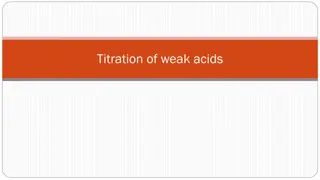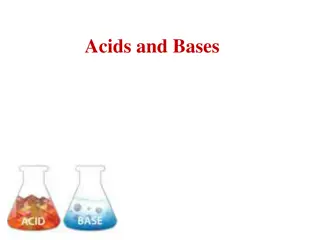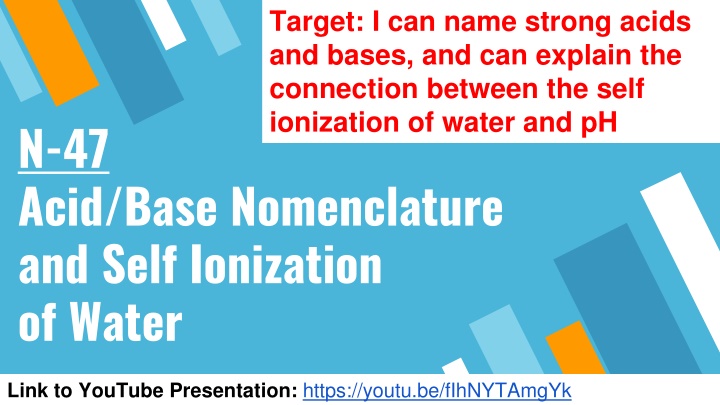
Acid and Base Nomenclature: Strong Acids and Bases Connection
Learn how to name strong acids and bases and explore the relation between water's self-ionization and pH levels. Dive into the nomenclature of acids, including binary and oxyacids, and discover the rules for naming different types of acids. Explore the concept of strong acids and bases, how they dissociate completely, and make calculations simpler. Watch the YouTube presentation for a comprehensive understanding.
Download Presentation

Please find below an Image/Link to download the presentation.
The content on the website is provided AS IS for your information and personal use only. It may not be sold, licensed, or shared on other websites without obtaining consent from the author. If you encounter any issues during the download, it is possible that the publisher has removed the file from their server.
You are allowed to download the files provided on this website for personal or commercial use, subject to the condition that they are used lawfully. All files are the property of their respective owners.
The content on the website is provided AS IS for your information and personal use only. It may not be sold, licensed, or shared on other websites without obtaining consent from the author.
E N D
Presentation Transcript
Target: I can name strong acids and bases, and can explain the connection between the self ionization of water and pH N-47 Acid/Base Nomenclature and Self Ionization of Water Link to YouTube Presentation: https://youtu.be/fIhNYTAmgYk
Acid Nomenclature Binary acid: Hydrogen + highly electronegative element HBr Steps to Name: 1) Begins with hydro 2) Add the root of the other element 3) Add ic 4) + acid Hydrobromic acid HCl Hydrochloric acid HI Hydroiodic acid
Acid Nomenclature Oxyacids: Hydrogen + oxygen + a third element Steps To Name: 1) Begins with Root of ion (not H or O) (sometimes starts with per- or hypo-) 2) Add ic, or -ous 3) + acid
Oxyacids Continued Names change a little depending on how many oxygens the anion comes with Anion ends with ate change ending to ic Anion ends with ite change ending to ous Anion has extra O than ate start with Per- Anion has fewer O than ite start with Hypo-
Oxyacids Continued less O version Hypochlorous Acid -ite version Chlorous Acid -ate version Chloric Acid more O version Perchloric Acid ClO- ClO2- ClO3- ClO4-
Some names are a little off to make them sound better, easier to say: Phosphoric acid not Phosphic acid Sulfuric acid not Sulfic acid Remember When writing formulas make them neutral! That is how you know how many hydrogens it has! H+ (CO3)2- H2(CO3) They get weird really fast Focus on the patterns, just get used to the weird ones
Naming Acids HF H2S HNO3 Hydrosulfuric acid Hydrofluoric acid Nitric acid HNO2 H2SO4 Nitrous Acid Sulfuric acid
Strong Acids and Bases STRONG? They dissociate completely HCl H++ Cl- HCl is a strong acid so LOTS of ions in solution! Strong Acids and Bases are the easy ones assuming the dissociate completely makes our math easier
MEMORIZE! The Seven Strong Acids 1) HCl Hydrochloric Acid 2) HBr Hydrobromic Acid 3) HI Hydriodic Acid Binary Acids 4) H2SO4 Sulfuric Acid 5) HNO3 Nitric Acid 6) HClO4 Perchloric Acid 7) HClO3 Chloric Acid Oxyacids
MEMORIZE! They are all hydroxides! The Eight Strong Bases 1) LiOH Lithium Hydroxide 2) NaOH Sodium Hydroxide 3) KOH Potassium Hydroxide 4) RbOH Rubidium Hydroxide 5) CsOH Cesium Hydroxide Alkali Metals Alkaline Metals 6) Ca(OH)2 Calcium Hydroxide 7) Sr(OH)2 Strontium Hydroxide 8) Ba(OH)2 Barium Hydroxide
Neutralization Reactions What happens when you mix a strong acid and strong base? It is always the same! Acid + Base Water + Ionic Salt HCl + NaOH H2O + NaCl H2SO4 + 2KOH 2H2O + K2SO4
Why is the pH of H2O equal to 7? Because water dissociates! It self ionizes not much but it does! ?2?(?)+ ?2?(?) + ?3?(??) Conj. Acid + Conj. Base + ??(??)
Back to Equilibrium Chapter! + ?2?(?)+ ?2?(?) ?3?(??) Conj. Acid + Conj. Base + ??(??) pH is a measure of ion concentration Dissociation is a reversible reaction So how do we find the [ ] of ions at equilibrium???? Equilibrium expressions!
Self Ionization of Water What is the equilibrium expression for water? ?2?(?)+ ?2?(?) Kw= [H3O+][OH-] + ?3?(??) + ??(??) Remember! Pure liquids aren t included in equilibrium expressions!
Self Ionization of Water [H3O+] and [OH-] are both equal to 1.0x10-7 M at 25oC. NOTICE ANYTHING??? Kw= [H3O+] [OH-] 1.0x10-14= [1.0x10-7]x [1.0x10-7]
Self Ionization of Water Kw= [H3O+] [OH-] 1.0x10-14= [1.0x10-7]x [1.0x10-7] The concentration of [H3O+] and [OH-] are equal So it is neutral! Also - The pH and the pOH of any aqueous solution are related through the Kw. That s why if you know one you can find the other! And why they add to 14 look at the exponents!
Self Ionization of Water Temperature Dependent The Kw changes based on temperature. In our practice problems we are always assuming it is at 25 C unless told otherwise. THINK! pH of water decreases as temperature increases BUT that does not mean it is acidic there is STILL [H+] = [OH-], it s just that the number we call neutral and the concentrations of ions at that temp is different than when at 25 C, pH 7. A neutral pH is only 7 at 25 !!!
KwCalculations What is the [H+] in an aqueous solution with a hydroxide ion concentration of 0.001 M at 25 C? (BTW THIS ONLY WORKS FOR AQUEOUS AT 25 C) Kw= [H+] [OH-] 1.0x10-14= [1.0 x 10-3] [H+] [H+] = 1 10 11 M
Video on Dissociation of Water https://youtu.be/Xeuyc55LqiY
Fun way to remember MOST of the strong/weak Acids/Bases Careful it doesn t have ALL of them! https://youtu.be/onGDi1KKjdM Missing: RbOH and CsOH They are not as common so some people leave them off
A good recap video Crash Course https://youtu.be/LS67vS10O5Y A video about buffers and Acid Rain if interested https://youtu.be/8Fdt5WnYn1k
23 YouTube Link to Presentation https://youtu.be/fIhNYTAmgYk

